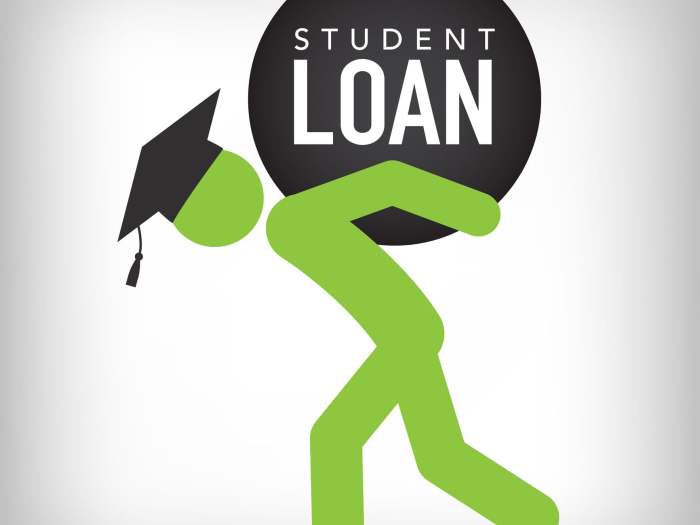
Embarking on graduate studies often necessitates navigating the complex landscape of student financing. The pursuit of advanced knowledge shouldn’t be hindered by financial uncertainty, and understanding your graduate student loan options is paramount to a successful academic journey and a manageable future. This guide provides a comprehensive overview of the various loan types available, helping you make informed decisions that align with your financial goals and academic aspirations.
From federal loan programs and their associated benefits to the intricacies of private loans and refinancing strategies, we’ll demystify the process. We’ll explore crucial aspects such as interest rates, repayment plans, and long-term financial implications, empowering you to confidently manage your debt and plan for a financially secure future.
Types of Graduate Student Loans

Securing funding for graduate school can be a significant undertaking. Understanding the various loan options available is crucial for making informed financial decisions and avoiding potential pitfalls. This section will Artikel the different types of graduate student loans, their features, and eligibility requirements.
Federal and Private Graduate Student Loans
Graduate students have access to two primary sources of funding: federal and private loans. Federal loans are offered by the U.S. government, while private loans are provided by banks, credit unions, and other financial institutions. Each type carries its own set of advantages and disadvantages.
Comparison of Federal and Private Graduate Student Loans
| Loan Type | Lender | Interest Rate Information | Repayment Options |
|---|---|---|---|
| Federal Graduate PLUS Loan | U.S. Department of Education | Fixed interest rate; rate is determined annually. | Standard repayment, extended repayment, graduated repayment, income-driven repayment plans. |
| Federal Direct Unsubsidized Loan | U.S. Department of Education | Fixed interest rate; rate is determined annually. | Standard repayment, extended repayment, graduated repayment, income-driven repayment plans. |
| Private Graduate Student Loan | Various banks, credit unions, and online lenders | Variable or fixed interest rates; rates vary widely depending on creditworthiness and other factors. | Repayment options vary widely depending on the lender. |
Advantages and Disadvantages of Federal vs. Private Graduate Student Loans
Federal graduate student loans generally offer advantages such as fixed interest rates, various repayment plans (including income-driven repayment), and deferment options during periods of unemployment or financial hardship. However, federal loan amounts may be limited, and the application process can sometimes be lengthy. Private loans, on the other hand, often offer larger loan amounts and potentially lower interest rates for borrowers with excellent credit. However, private loans typically lack the same borrower protections and flexible repayment options as federal loans. Interest rates can be variable, and repayment terms may be less forgiving.
Eligibility Requirements for Graduate Student Loans
Eligibility requirements vary depending on the type of loan. Federal loans typically require U.S. citizenship or permanent residency, enrollment at least half-time in a graduate program at a participating institution, and a valid Social Security number. Credit checks are not always required for federal loans. Private loan eligibility is determined by individual lenders, but typically involves a credit check, income verification, and sometimes a co-signer requirement. The specific requirements will depend on the lender and the applicant’s creditworthiness. For example, a strong credit history will generally lead to better loan terms and higher approval chances.
Federal Graduate Student Loan Programs

Federal graduate student loans offer a crucial funding source for advanced education, providing access to higher learning for many students. These loans, unlike private loans, are backed by the U.S. government, offering potential benefits like lower interest rates and flexible repayment options. Understanding the application process and available repayment plans is essential for effectively managing your student loan debt.
The Federal Graduate Student Loan Application Process
Applying for federal graduate student loans primarily involves completing the Free Application for Federal Student Aid (FAFSA). This application collects information about your financial situation and educational goals to determine your eligibility for federal aid, including loans, grants, and work-study programs. The process is straightforward but requires careful attention to detail to ensure accurate information is provided.
Completing the Free Application for Federal Student Aid (FAFSA)
The FAFSA is a comprehensive application that requires detailed personal and financial information. A step-by-step guide to completing the FAFSA includes:
- Creating an FSA ID: Before starting the application, both the student and a parent (if dependent) need to create an FSA ID, a username and password used to access and manage the FAFSA. This ID is also used to electronically sign the FAFSA.
- Gathering Required Information: Collect your Social Security number, driver’s license (if applicable), federal tax returns (yours and your parents’, if dependent), W-2s, and other relevant financial documents. Accurate information is crucial for a timely and successful application.
- Completing the Application: The online application asks for demographic information, educational goals, and financial details. Answer all questions accurately and completely. The system will guide you through each section.
- Reviewing and Submitting: Thoroughly review the completed application for accuracy before submitting it. Errors can lead to delays in processing.
- Tracking Your Application: After submitting, track your application status online through the FAFSA website. This allows you to monitor the processing of your application and anticipate any further requirements.
Federal Graduate Student Loan Repayment Plans
Several repayment plans are available for federal graduate student loans, each with its own terms and conditions. Choosing the right plan depends on individual financial circumstances and repayment goals.
- Standard Repayment Plan: This plan involves fixed monthly payments over a 10-year period. It’s the most common plan and offers the shortest repayment timeframe.
- Graduated Repayment Plan: This plan starts with lower monthly payments that gradually increase over time. This can be beneficial in the early years after graduation when income may be lower.
- Income-Driven Repayment Plans (IDR): These plans link monthly payments to your income and family size. They offer lower monthly payments but may extend the repayment period to 20 or 25 years. Examples include Income-Based Repayment (IBR), Pay As You Earn (PAYE), Revised Pay As You Earn (REPAYE), and Income-Contingent Repayment (ICR).
Loan Consolidation and Refinancing
Managing multiple graduate student loans can be complex, often involving varying interest rates, repayment schedules, and lenders. Loan consolidation and refinancing offer strategies to simplify this process and potentially reduce overall borrowing costs. Understanding the nuances of each is crucial for effective debt management.
Loan consolidation involves combining multiple federal student loans into a single, new federal loan. This simplifies repayment by reducing the number of monthly payments and potentially offering a more manageable repayment schedule. The interest rate on the consolidated loan is typically a weighted average of the interest rates on the original loans. This process is managed through the Federal Student Aid website.
Federal Loan Consolidation
The process of federal loan consolidation involves applying through the Federal Student Aid website. Borrowers will need to provide information about their existing loans, including loan numbers and lender information. Once approved, the new consolidated loan is disbursed, and payments on the original loans cease. It’s important to note that consolidating federal loans does not change the total amount owed, nor does it lower the interest rate significantly, except potentially in cases of Income-Driven Repayment plans, which may offer a lower monthly payment amount. However, it does simplify the repayment process. For example, a graduate student with three separate federal loans, each with a different repayment schedule and interest rate, could consolidate them into a single loan with one monthly payment and a fixed interest rate. This streamlines the repayment process and reduces administrative burdens.
Refinancing Graduate Student Loans
Refinancing involves replacing your existing student loans with a new loan from a private lender. This often offers the potential for a lower interest rate, a shorter repayment term, or both, leading to significant savings over the life of the loan. However, refinancing federal loans means losing access to federal loan benefits such as income-driven repayment plans and deferment options.
Benefits and Drawbacks of Refinancing
Refinancing can offer substantial benefits, such as a lower monthly payment, a shorter repayment period, and potentially significant interest savings over the life of the loan. However, it’s crucial to carefully weigh the drawbacks. Refinancing typically requires a good credit score and a stable income. Furthermore, refinancing federal loans removes access to federal loan forgiveness programs and income-driven repayment plans. For example, a borrower with excellent credit could refinance their graduate student loans and secure a lower interest rate, reducing their monthly payment and overall interest paid. Conversely, a borrower with poor credit might not qualify for refinancing, or might receive a less favorable interest rate than their existing federal loans.
Scenarios Where Consolidation or Refinancing Might Be Beneficial
Consolidation is beneficial when managing multiple federal loans with different interest rates and repayment schedules becomes overwhelming. Refinancing might be advantageous when interest rates are lower than those on existing loans, or when a shorter repayment term is desired, provided the borrower meets the lender’s eligibility requirements and understands the loss of federal benefits. For instance, a recent graduate with several federal loans might find consolidation beneficial for simplifying repayment. A borrower with high credit scores and a stable income might find refinancing advantageous to secure a lower interest rate and potentially save thousands of dollars over the life of the loan.
Understanding Loan Terms and Fees

Navigating the world of graduate student loans requires a clear understanding of the associated terms and fees. Failing to grasp these crucial aspects can lead to unexpected costs and financial difficulties down the line. This section clarifies key loan terminology and details the various fees you might encounter.
Understanding the terminology surrounding your graduate student loans is paramount to making informed decisions about borrowing and repayment. Key terms directly impact your overall loan cost and repayment schedule.
Key Loan Terms
Several key terms define the structure and cost of your graduate student loan. Familiarizing yourself with these will allow you to better understand your repayment obligations.
- Interest Rate: This is the percentage of your loan principal that you pay as interest each year. A higher interest rate means you’ll pay more in interest over the life of the loan. Interest rates can be fixed (remaining constant throughout the loan term) or variable (fluctuating based on market conditions).
- Principal: This is the original amount of money you borrowed. Your monthly payments go towards paying down both the principal and the interest accrued.
- Amortization: This is the process of paying off a loan over time through regular payments. Each payment typically covers a portion of the principal and the accrued interest. A standard amortization schedule shows the breakdown of principal and interest for each payment over the loan’s life.
- Grace Period: This is the period after you graduate or leave school before you are required to begin making loan repayments. The length of the grace period varies depending on the loan type. It provides a buffer to help you transition into repayment.
Loan Fees
Beyond the interest rate, several fees can significantly impact the total cost of your graduate student loan. These fees should be considered when budgeting for your education.
- Origination Fees: These are fees charged by the lender when the loan is disbursed. They are typically a percentage of the loan amount. These fees increase the total cost of borrowing.
- Late Payment Fees: These are penalties imposed if you miss a loan payment. The amount varies depending on the lender. Consistent on-time payments avoid these extra charges.
- Prepayment Penalties: Some loans may charge a fee if you pay off the loan early. This is less common with federal student loans but may be present in private loans. Always check the loan terms.
- Default Fees: If you default on your loan (fail to make payments), you’ll incur significant fees and potentially damage your credit score. This can have long-term financial repercussions.
Calculating Total Loan Cost
Calculating the total cost of a graduate student loan requires considering both the principal and the accumulated interest over the repayment period. This calculation provides a clear picture of your total financial obligation.
The simplest way to estimate the total cost is to use an online loan calculator. Many free calculators are available. These calculators typically require the loan amount, interest rate, and loan term as inputs. They then provide an estimate of the total interest paid and the total repayment amount.
For example: A $50,000 loan with a 7% interest rate over 10 years could result in a total repayment amount exceeding $70,000, due to accumulated interest. The exact amount will vary based on the amortization schedule.
Impact of Graduate Student Loans on Future Finances
Embarking on graduate studies often requires significant financial investment, and graduate student loans frequently play a crucial role in bridging this gap. However, understanding the long-term financial implications of these loans is paramount to ensuring a stable and secure future. Careful planning and strategic decision-making are essential to navigate the complexities of loan repayment and its impact on major life milestones.
Graduate student loan debt can significantly influence your financial trajectory for years, even decades, after graduation. The monthly payments can represent a substantial portion of your post-graduation income, impacting your ability to save for retirement, invest in other opportunities, or manage unexpected expenses. The total amount of debt, the interest rate, and the repayment plan all contribute to the overall burden. Higher interest rates can accelerate the growth of your debt, while longer repayment periods can extend the impact on your budget. The earlier you begin to address these factors, the better positioned you will be to manage your finances effectively.
Loan Repayment Strategies After Graduation
Developing a robust repayment strategy is crucial for minimizing the long-term impact of graduate student loans. This involves understanding your repayment options, such as standard repayment, extended repayment, graduated repayment, and income-driven repayment plans. Each plan offers different monthly payment amounts and repayment periods, affecting the total interest paid over the life of the loan. Creating a detailed budget that accounts for loan payments, alongside other essential living expenses, is vital. Exploring opportunities for additional income, such as part-time employment or freelance work, can help accelerate repayment. Furthermore, actively monitoring your credit score and maintaining a good credit history are essential for securing favorable interest rates on future loans or credit products. For example, someone with a $100,000 loan at 7% interest on a standard 10-year repayment plan will pay significantly more in interest than someone who aggressively pays down the principal or refinances to a lower interest rate.
Impact on Major Life Decisions
The weight of graduate student loan debt can significantly influence major life decisions, such as purchasing a home or starting a family. High monthly loan payments can restrict your ability to save for a down payment on a house, potentially delaying homeownership. Similarly, the financial burden of loan repayments can affect decisions related to having children, impacting choices around childcare costs, healthcare expenses, and overall family budgeting. For instance, a couple facing significant student loan debt might delay buying a home until their loan payments are reduced or they have a higher disposable income. Similarly, they might choose to delay starting a family until their financial situation improves. These are not insurmountable obstacles, but careful planning and realistic budgeting are essential to navigate these life stages while managing loan repayments.
Final Review
Securing funding for graduate education requires careful consideration and strategic planning. By understanding the diverse landscape of graduate student loan options—federal versus private, repayment plans, and long-term financial consequences—you can make informed decisions that support your academic pursuits without compromising your future financial well-being. Remember, proactive planning and informed choices are key to successfully managing your loan debt and achieving your long-term financial objectives.
Q&A
What is the difference between subsidized and unsubsidized federal loans?
Subsidized loans don’t accrue interest while you’re in school, during grace periods, or while in deferment. Unsubsidized loans accrue interest from the time the loan is disbursed.
Can I get a graduate student loan without a co-signer?
Federal graduate student loans generally don’t require a co-signer. Private lenders, however, often require a co-signer, especially for borrowers with limited credit history or low credit scores.
What happens if I can’t make my loan payments?
Contact your lender immediately. Options like deferment, forbearance, or income-driven repayment plans may be available to help manage temporary financial hardship. Failure to communicate can lead to serious consequences.
How can I improve my chances of loan approval?
Maintain a good credit score, demonstrate a stable income, and provide accurate and complete information on your loan application. A co-signer can also strengthen your application.
